|
CLASSIC FILM STARS
LINDA DARNELL
Career overview by William Schoell
Linda Darnell was a teenage beauty queen brought to Hollywood
from Dallas and turned into a star by the studio system which typically abandoned her when she was no longer a draw. Twentieth
Century-Fox immediately threw her into Hotel for Women in 1939, in which she appeared
alongside Ann Sothern, Lynn Bari, James Ellison and Elsa Maxwell. In her next film she became Tyrone Power's leading lady
in Daytime Wife (1939). She quickly graduated from minor films such as Star
Dust (1940) and Brigham Young (1940),
another co-starrer with Tyrone Power, into more important projects such as Chad Hanna (1940) with Henry Fonda, and Blood and Sand (1941)
with Rita Hayworth, Nazimova, and – again-- Tyrone Power.
| Linda Darnell and Tyrone Power |
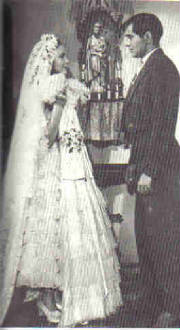
|
| BLOOD AND SAND |
Blood and Sand is about a bullfighter,
Juan (Power), who virtually deserts the wife who has stood by him for a sexy rich lady who tires of him when the next hot
matador comes along. Rita Hayworth was cast as the rich lady and Linda had the misfortune of being cast in the less showy
role of Juan's wife, Carmen. Although Darnell was perfectly accomplished and professional in the role, she was simply too
sophisticated to be entirely convincing as a quiet small-town Spanish girl devoted to husband and church. When she confronts
Hayworth late in the picture, Darnell has to be subdued and restrained when you sense she really would have liked to tear
Hayworth's hair out (and it would have been much more fun if she had). In the meantime, Hayworth's
depictions of savage lust distort her face to such a degree that she resembles a cat with arched eyebrows and looks surprisingly
unattractive through much of the movie (and perhaps she wasn't made up to advantage, as well). However her dance with Anthony
Quinn – her next boy toy – in the tavern is incredibly sexy. Power plays with boyish abandon and if he's hardly
perfect for the part this is probably one of his better performances. Of course the performances of the headlining trio can't
compare to those of the sterling supporting cast, including Laird Cregar as a nasty critic, Curro; J. Carrol Niash as a washed up bullfighter who goes to work for Power; and
especially Nazimova as Power's anguished and morally confused mother. John Carradine, who got lost
in so many grade D horror films throughout his career, really scores as an associate of Power's in the bullring, and young
Rex Downing is quite good as Juan as a boy. While the picture is pretty superficial, director Rouben
Mamoulian gets across the grotesque nature of the “sport” and there are several well-crafted
sequences. Oddly, for a movie about a matador, the camera doesn't go into the bullring all that often.

|
| "My Darling Clementine" 1946 |
In 1942 Darnell gave a very
creditable performance as Virginia in The Loves of Edgar Allan Poe (see review above), but critics couldn't seem to get beyond her beauty, treating her simply as if she were a mannequin
with good bone structure who photographed well. The truth was that Darnell gave some surprisingly accomplished performances
even early in her career when she was still learning her craft. In 1943 she appeared unbilled as the
vision of the Virgin Mary who appears to Jennifer Jones in Song of Bernadette.
She also had good roles in Douglas Sirk's Summer Storm
(1944) and in Hangover Square (1945) with Laird Cregar.

|
| Darnell in "Fallen Angel" |
“Love alone can make a fallen angel rise,” Alice
Faye quotes to the confused, amoral man she's in love with, “for only two can enter paradise.” In Fallen Angel – one of Darnell's more interesting pictures -- Faye is targeted by gold
digger Dana Andrews, who needs Faye's money to run off with Linda Darnell's waitress, who dates a variety of men in
the hopes of landing one who can give her the good life. About halfway through the film Darnell is murdered, and Andrews,
his new wife, Faye, and his somewhat stern sister-in-law Anne Revere each become chief suspects for policeman Charles Bickford. The identity of the killer comes as no surprise, but the film holds the attention in spite of
it. Director Otto Preminger seems more interested in this material than he was in Forever Amber. The somewhat stilted, almost wooden acting style of Dana Andrews eventually seems appropriate for the character,
Faye manages a generally convincing dramatic performance with a degree of sensitivity, and Darnell is quite good and entirely
convincing (if devoid of nuance) as the hard waitress who longs for a less demanding and more exciting life. Of the supporting
cast, Bickford is solid, Bruce Cabot does a nice turn as another suspect (although it's had to believe he wouldn't take a
whack at sadistic cop Bickford when the latter beats him), Anne Revere is as perfect as ever, and Percy (“Pa Kettle”)
Kilbride is rather touching as the old man employer who loves Darnell unrequitedly
more than everyone else put together – what inspired casting! An interesting if imperfect picture.
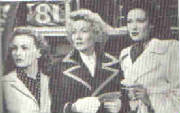
|
| "Letter to Three Wives" |
After Fallen Angel Darnell made an impression in Anna and the King of Siam
(1946/see review above) with Irene Dunne and Rex Harrison, and then was tapped for the lead in the film adaptation of the
bestselling potboiler Forever Amber (1947/see review above). Her performance
was vital but perhaps not as ferocious as it needed to be. She was teamed with Rex Harrison again in Preston Sturges'
odd production of Unfaithfully Yours (1948),
and then got what is probably her best and most memorable role in Joseph Mankiewicz's A
Letter to Three Wives ((1949/see review above), in which she was completely convincing,
wryly amusing, and altogether expert. Unfortunately her follow up to this was the disappointing Slattery's
Hurricane.
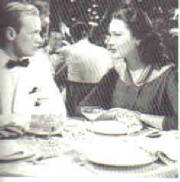
|
| "Slattery's Hurricane" |
Darnell was not seen to good advantage in Slattery's Hurricane, and although her performance is at least professional, it's also a bit perfunctory, matched by
Richard Widmark's usual workmanlike if uninspired thesping. The picture proceeds
as a series of flashbacks as Widmark recklessly flies his plane through a hurricane. The back story
deals with his relationship with two women: an oddly subdued and almost matronly Veronica Lake, who is not nearly as sexy
without her “peekaboo bangs,' and Darnell, with whom he once had a grand passion but who is now married to one of his
best friends. Lake thinks Widmark is a stinker not only for going out on her but for fooling around with his friend's wife.
Love scenes between Darnell and Widmark aren't bad, but they haven't much chemistry together. Darnell doesn't look especially
beautiful in the film, with a bad hairdo and a face that seems positively out-sized, although she's certainly attractive.
Her mind seems to be on other things. The picture is eminently forgettable. The following year she did another film with Widmark,
No Way Out, this time for Mankiewicz again.
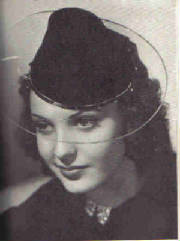
|
| Darnell at fifteen |
Otto Preminger cast Linda
in The Thirteenth Letter (1951), his Americanized
adaptation of Le Corbeau (The Crow), about a town wracked
by a series of poison pen letters. The following year she was teamed with Tab Hunter in Island of Desire. 1953 found her teamed with Robert Mitchum in Second Chance. She made a few more movies, including two in Italy, but she was
essentially washed up the late fifties. (Her last film, Black Spurs, appeared
in 1965.) To support herself, Linda started acting in plays, but she could never really deal with the collapse of the kind
of life and fame she had literally known for all of her adult life and began drinking heavily. This led to episodes in which,
her adopted daughter Lola told biographer Ronald L. Davis, she became extremely violent and even tried to stab twelve-year-old
Lola with a knife (shades of Mommie Dearest!). She
had three marriages and three divorces. At the time of her tragic death, Darnell was about to file for bankruptcy but she
tried to keep her spirits up. Her last night on Earth she was staying at a friend's house where they all stayed up late to
watch one of Linda's first movies. A fire broke out in the house but Linda didn't get out in time and was so severely burned
that she literally had no skin left on her body -- she had no face. It is possible she had no idea how seriously she
had been injured as she was too badly burned to even feel pain. Mercifully, perhaps, she died in the hospital not long after
the accident.. She was forty-three years old.
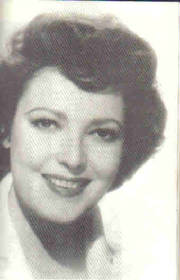
|
| Linda Darnell |
RECOMMENDED BIOGRAPHY: Hollywood Beauty: Linda Darnell and the American Dream. Ronald L. Davis. University
of Oklahoma; 1991.
Other films: Star Dust (1940)
with John Payne; The Mark of Zorro (1940), with Ty Power, Gale Sondergaard, and Basil Rathbone; Rise and Shine (1941); City Without Men (1943); Rene Clair's It Happened Tomorrow
(1944) with Dick Powell; William Wellman's Buffalo Bill (1944) with Joel McCrea and Maureen
O'Hara; Archie Mayo's Sweet and Low-Down (1944); The Great John L (1945); Centennial Summer with Cornel
Wilde; John Ford's My Darling Clementine (1946) with Henry Fonda; The Walls of Jericho (1948); Edmund Goulding's Everybody Does It (1949), with Paul Douglas, Celeste Holm, and Charles Coburn;
Robert Wise's Two Flags West (1950) with Joseph Cotton, Jeff Chandler, and Cornel Wilde; The Guy Who Came Back
(1951 with Paul Douglas and Joan Bennett; Douglas Sirk's The Lady Pays Off (1951); Night without Sleep (1952)
with Gary Merrill and Hildegarde Neff; Raoul Walsh's Blackbeard the Pirate
(1952) with William Bendix; Donne proibite/Angels of Darkness (1953) with Anthony Quinn; This is My Love (1954)
with Dan Duryea and Faith Domergue; Gli ultimi minuti/ The Last Five Minutes
(1955) with Vittorio De Sica and Rossano Brazzi; Dakota Incident (1956) with Dale Robertson
and John Lund; Hall Bartlett's Zero Hour (1957) with Dana Andrews and Sterling Hayden.
MORE CLASSIC FILM STARS
This issue we feature a major article on KATHARINE HEPBURN (Articles Page) and a look at the continuing
controversy over JOAN CRAWFORD (Crawford Controversy). Also see pictures of Cary Grant, Jayne Mansfield, Gloria Swanson, Marcello
Mastroianni and others on LARRY QUIRK'S HOLLYWOOD PHOTO PAGE! {NOTE: You can click on the links below to go to these pages.}
MORE CLASSIC FILMS
And don't forget our sister site, Quirk's Reviews, which is entirely devoted to classic films and film stars. Click here to go directly to the site: http://quirksreviews.tripod.com.
KATHARINE HEPBURN ARTICLE
JOAN CRAWFORD: THE HATE GOES ON
LARRY QUIRK'S HOLLYWOOD STARS PHOTO PAGE
CLASSIC AND RECENT HORROR AND SCI FI FILMS ON OUR MACABRE MOVIES PAGE
Please pardon our appearance as we revamp this web site. A change in format has created some lay out
and photo problems which we will correct as soon as possible. Many thanks for your patience. -- The Editors
NOTE: press "home" on your keyboard to go straight back
up to the top
HIGH AND LOW NY: THE PERFORMING ARTS AND ENTERTAINMENT
NEWSLETTER
Entire contents copyrighted 2004 - 2005 by William Schoell and Lawrence
J. Quirk, except for items written by other authors, in which case said authors retain the copyright of their work .
Opinions expressed by individual authors and reviewers are not necessarily the opinions of High and Low NY.
|

